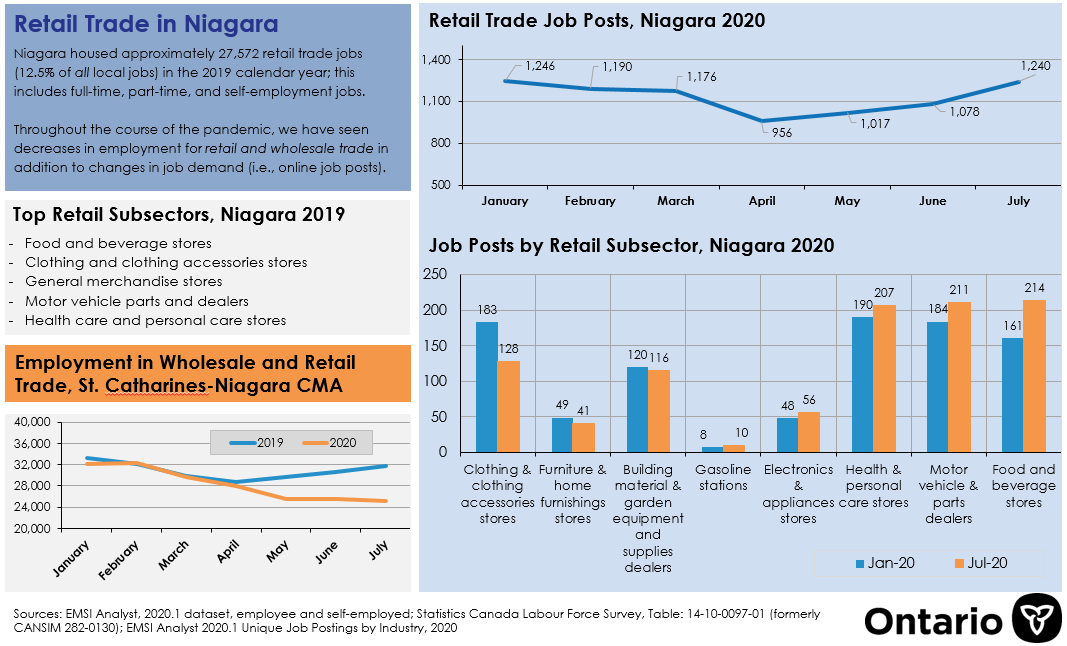This briefing note is part of a series on COVID-19 and its impact on the retail trade sector. Other briefing notes in this series focus on retail trade employers, demographic details of retail trade employees, and the link between retail trade and the tourism sector. This note highlights the state of the labour force within Niagara’s retail trade sector prior to and during the COVID-19 pandemic. To provide insights on the effects of the pandemic on this sector, we also provide data on employment and job demand in the retail trade sector for the first half of 2020. The data show that measureable job demand within the retail trade sector has declined during the COVID-19 pandemic.
2019 Retail Trade Jobs
Niagara housed approximately 27,572 retail trade jobs (12.5% of all local jobs) in the 2019 calendar year; this includes full-time, part-time, and self-employment jobs. The most prominent retail trade subsector was food and beverage stores, which represented 27.4% of full- and part-time jobs within the retail trade sector. The top retail subsectors by number of jobs are presented in Table 1.
Table 1: 2019 Jobs by retail trade subsector (top-5), Niagara
The Impact of COVID-19 on Retail Trade Employment
Data from Statistics Canada’s monthly Labour Force Survey highlight a significant drop in the number of people employed in the wholesale and retail trade industry following the outbreak of the pandemic. Specifically, between February and June 2020, the number of people working in this industry decreased from 32,300 to 24,900 (see Figure 1). This shift in employment contrasts the typical seasonal increase that we see during this period and was significantly larger than what was seen during the first half of 2019.
Figure 1: Number of people employed in the wholesale and retail trade industry, St. Catharines-Niagara CMA
The Impact of COVID-19 on Retail Trade Job Demand
In addition to changes in employment, we can also examine the impact of COVID-19 on measureable job demand. As expected, we see a decrease in postings immediately after the pandemic was declared. Unique job postings for retail trade positions in Niagara declined from 1,176 in March to 956 in April. Since April, we have seen an increase in measureable job demand, such that unique job postings in July reached the same level seen in January (see Figure 2). We will continue to monitor job demand as local and provincial responses to COVID-19 adapt to changing realities over the coming months.
Figure 2: Job postings by month, retail trade, January-July 2020, Niagara
Keeping in mind that a number of retail businesses were deemed essential and, therefore, remained open, we broke down job posting data by retail trade subsector. Table 3 shows that job postings for clothing and clothing accessories stores decreased by 55 between January and July. In contrast, food and beverage stores saw an increase of 53 job postings over the same time period.
Table 2: Job Postings by month retail trade subsectors, January-July 2020, Niagara
As this project progresses, we will be closely monitoring the changes in retail trade employment in relation to COVID-19. As noted above, July 2020 saw a slight increase (200 people) in the number of people employed in wholesale and retail trade compared to June, though this number is still significantly lower than the employment numbers from February. At the same time, online job postings for positions in retail trade have already rebounded to their pre-pandemic levels, with July seeing 50 more unique job postings compared to February 2020. However, these postings have not been equally distributed among retail trade subsectors. We will continue monitoring employment and job posting trends to better understand whether these trends continue throughout the duration of the pandemic.




